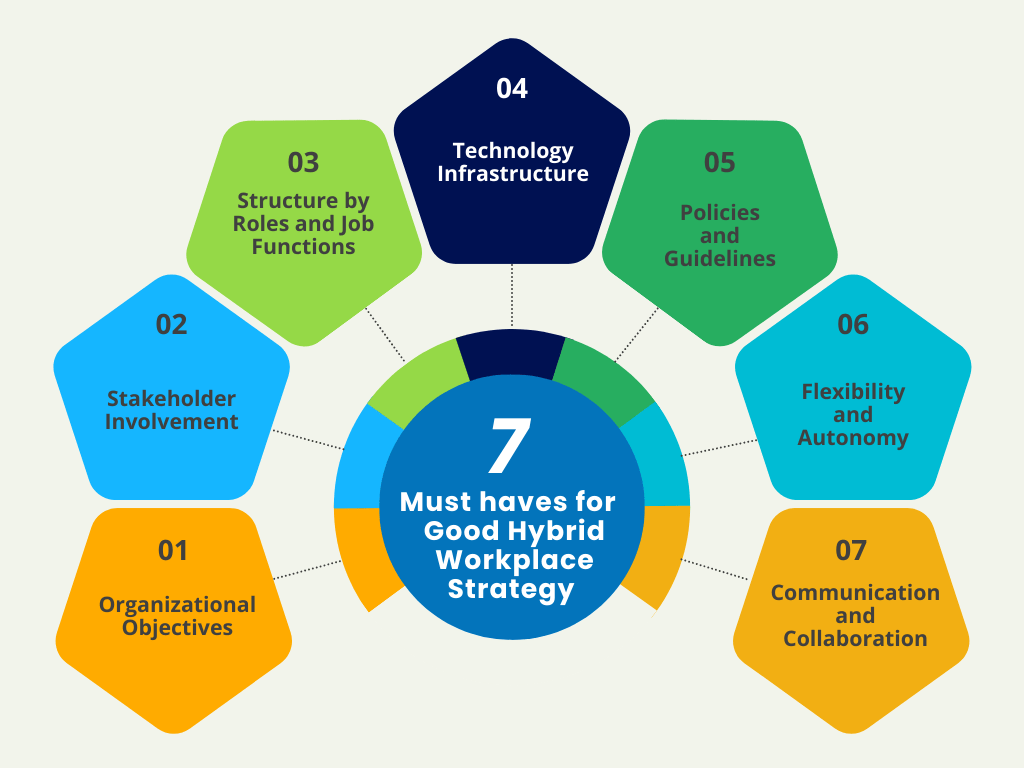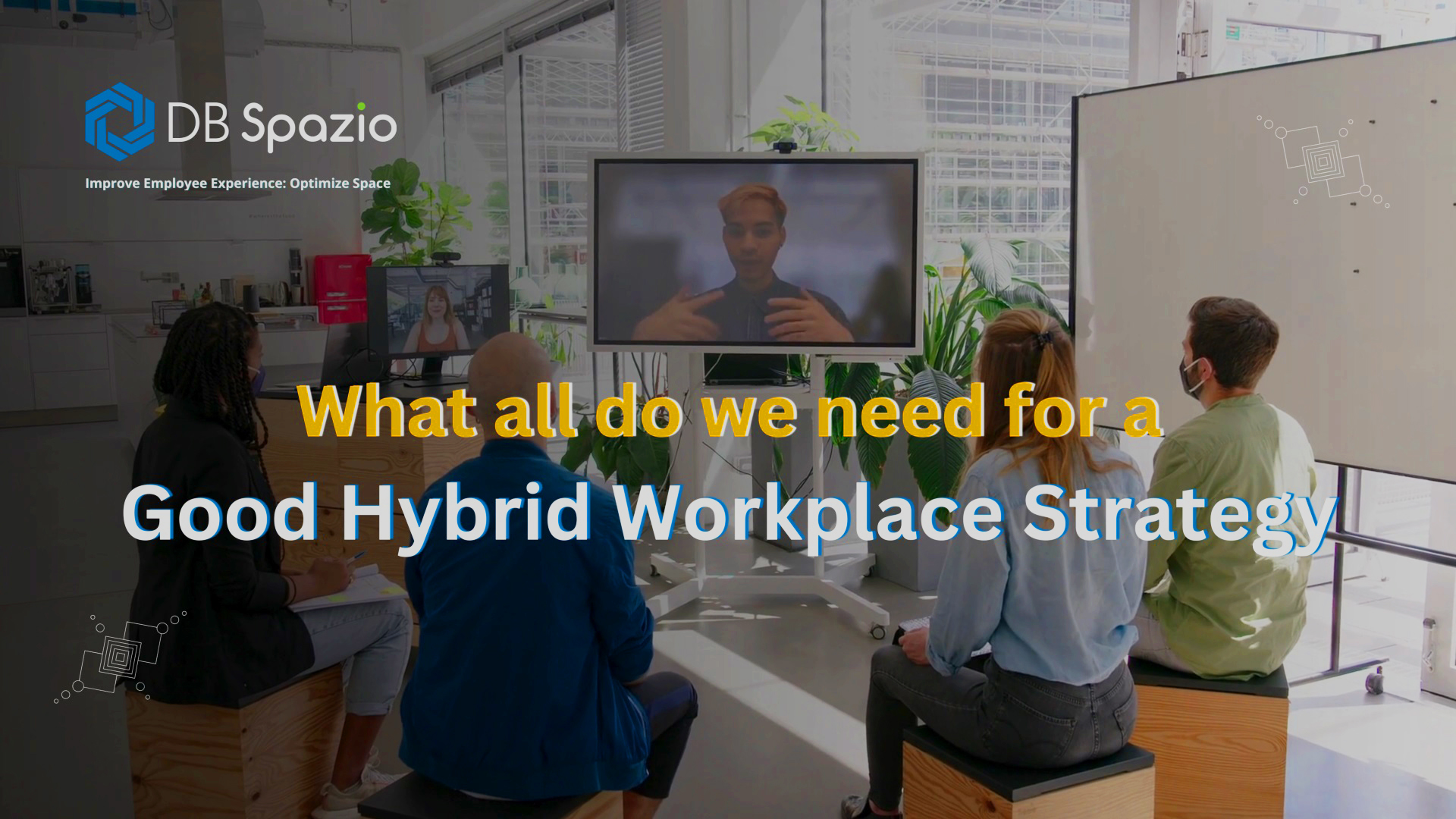Introduction
Work dynamics have radically changed in past few years. As employees move away from traditional office schedules or full remote work, Hybrid Workplace Strategy becomes imperative, marking hybrid work as the “New Norm” for 2023, as highlighted by Donna Williams, Chief People Officer at IR in her recent article.
But the main question is: Why is Hybrid Work Strategy Important for businesses and how can a strong strategy be crafted by understanding its formulation and considering key factors?
Before delving into these answers, let’s first explore the components of a hybrid workplace, along with its benefits and challenges.
What Hybrid Working consists of?

Hybrid work is a versatile working arrangement that blends both office and remote work facilities., giving employees the freedom to choose their work settings and schedules while adhering to company policies.
This working pattern didn’t suddenly emerge due to the pandemic, rather it dates to early 2000s as home internet connectivity reached a level of reliability suitable for remote work.
Pros & Cons of Hybrid Work Models
Now, let’s take a closer look at both advantages and obstacles organizations might encounter when transitioning to a hybrid work model.
Pros
- Increases flexibility with respect to work, fostering better work-life balance for employees and reducing the constraints of a traditional office schedule.
- Enhances well-being, reduces stress, improves productivity & job satisfaction.
- Reduces office-related costs, including rent, utilities, and maintenance, leading to significant savings for organizations and improving their financial performance.
- Attracts a diverse talent pool, providing a competitive edge in the job market.
Cons
- Maintaining team cohesion and culture across locations is challenging due to physical distance.
- Mandates effective remote team management, including trust-building, clear expectations, and the use of appropriate tools.
- Protection of data and remote workspaces is vital, including defences against breaches, phishing, and unauthorized access, alongside employee education.
- Lack of clear communication may be an obstacle if right tools are not used, impacting effective collaboration.
Importance of Hybrid Workplace Strategy

The emerging hybrid work model necessitates a well-planned implementation strategy to maximize its benefits while minimizing potential challenges typically associated with this mode of work.
What is a Hybrid Workplace Strategy?
An effective hybrid workplace strategy is a thoughtfully crafted plan that finds the perfect equilibrium between remote and in-person work, with the goal of enhancing productivity, fostering employee well-being, and driving business success, all while being attuned to an organization’s distinct requirements and objectives.
How does a well-formulated strategy help businesses?
This thoughtfully designed workplace strategy empowers businesses to harness the advantages of a hybrid work model, which include:
- Improved working flexibility and employee well-being.
- Significant cost savings on office spaces and utilities.
- Streamlined space management for enhanced efficiency.
- Facilitated collaboration among geographically dispersed teams.
Furthermore, it ensures a proactive approach to tackle the following challenges associated with hybrid work:
- Mitigating communication issues.
- Enhancing data security.
- Effectively managing remote teams.
Formulating a Comprehensive Strategy for Hybrid Workplace

- Organizational Objectives: Ensure alignment with organizational needs, including workspace allocation, cost savings, employee well-being, increased productivity, and superior talent retention via an exceptional workplace experience.
- Stakeholder Involvement: Determine the requirements, preferences, and key concerns of important stakeholders involving employees, IT, CRE Leadership team.
- Structure by Roles and Job Functions: Recognize that distinct roles within the organization may have varying requirements for remote and in-person work. Tailor the strategy to accommodate the diverse needs of workforce of different departments and roles.
- Technology Infrastructure: Make sure the Hybrid Workplace Strategy is backed by the organization’s technology infrastructure, covering hardware, software, and network capabilities.
- Policies and Guidelines: Develop clear policies and guidelines for remote work expectations, communication protocols, performance metrics, and compliance with labour laws.
- Flexibility and Autonomy: Recognize the value of flexibility in the strategy, giving employees a voice in their work setups and establishing a framework that encourages independence while upholding responsibility.
- Communication and Collaboration: Establish seamless communication and collaboration among remote and on-site team members using technology like video conferencing, chat tools, and regular team meetings.
These principles should guide your organization’s transition plan towards a successful hybrid workplace. Remember that a one-size-fits-all approach might not work for every company, so tailor your strategy to the hybrid work model you adopt based on your specific needs and organizational culture. For more detailed guidance on hybrid work models, refer to Your Guide : Choosing the Right Hybrid Work Model & Essential Technology
Role of technology in Hybrid Workplaces

Relying solely on manual planning or usage of siloed tools tailored for specific purposes might not be the most effective approach when striving for successful management of an organization within a hybrid work model.
It requires a unified technology solution that fulfils all the following hybrid work requirements of the organisation:
- Workplace Scheduling: Streamline scheduling with AI-driven seat allocation, promoting collaboration and enhancing the employee experience.
- Space Management: Efficiently configure workspace with 3D layouts and help employees making AI-powered reservations of various resources such as desks, meeting rooms, amenities etc.
- Workplace Integration: Create unified experiences with mobile, web, and kiosk interfaces, IAQ monitoring, and SOS features.
- Space Planning and Optimization: Streamline the process of arranging office space on digital floor plans and leveraging AI-driven forecasting. Automate seat requests, allocations, and assignments for departments through a customizable workflow. Enhance real estate utilization through efficient “what-if” analysis.
- Data-Driven Decision-Making: Utilize workplace data analytics for informed decisions on occupancy and utilization.
Crafting an effective Hybrid Workplace Strategy with DB Spazio
To meet these hybrid workplace management needs, companies can choose from various technology solutions, such as DB Spazio.
DB Spazio is a cutting – edge platform designed to enhance the hybrid workplace experience and provides a comprehensive solution to facilitate a smooth return to work.
The Workplace Trinity Approach
DB Spazio operates under three key pillars, ensuring a comprehensive approach to a successful hybrid workplace strategy:

- Hybrid Workplace : DB Spazio promotes seamless collaboration and productivity for both in-office and remote work while providing valuable analytics for efficient real estate management.
- Employee Wellness : Focuses on productivity, comfort, and hygiene, creating a workspace where employees feel healthy, happy, and valued.
- Energy & Sustainability : Promotes energy efficiency, savings, and ESG (Environmental, Social, Governance) compliance, contributing to a sustainable future.
Here’s how one can leverage DB Spazio to create a winning strategy:
- Collaboration at Workplace
- Reservations & Amenities using AI
- Unified & Seamless Workplace Experience
- Smart Space Planning & Optimization
- Workplace Analytics for Data driven decisions
Success Stories with DB Spazio

DB Spazio has supported enterprises like Fortune 100 American multinational investment bank and financial services corporation, headquartered in New York City.
The Fortune 100 bank was an early adopter of hybrid working, even prior to the pandemic, and wanted to stay ahead of the curve by building the ‘workplace of the future’ for their 4000+ employees.
The Challenges:
- Provide employees with a safe, productive, and engaging hybrid work experience
- Encourage office attendance, optimize space utilization, and save costs
- Ensure security and privacy of employee data
Solution:
Our team worked closely with the client to technology enable their hybrid workplace strategy while ensuring the compliance and security needs. DB Spazio and its comprehensive workplace experience platform ensured that they were able to confidently adopt a hybrid work model & created unique and differentiated employee experience that was unparalleled.
Outcome:
The transformation towards becoming a flexible and tech-driven hybrid workplace was achieved with the optimal seating of 3000 seats (for 4000+ employees).
Testimonial given by Fortune 100 Bank executive, clients of DB Spazio:
“DB Spazio’s solution is the tech backbone of our ‘Workplace of The Future’ and various employee experiences for a workplace that is Efficient, Healthy & Safe.”
VP – Projects
To learn about how DB Spazio tackled challenges of Fortune 100 bank and the resulting performance metrics, please refer to the complete case study for in-depth information: How a Fortune 100 Bank Stayed Ahead of the Curve by creating Unparalleled Hybrid Workplace Experience
Conclusion
Hybrid workplace is the new normal, and crafting an effective strategy is essential for success. It requires aligning with organizational objectives, involving stakeholders, and leveraging technology solutions like DB Spazio. With a well-structured strategy, organizations can navigate the evolving work landscape, balancing flexibility, productivity, and employee well-being, and emerge stronger in this new era of work.




